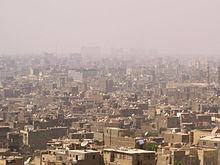Legal regulations
Smog in Cairo
Canada
In Canada air pollution and associated health risks are measured with the The Air Quality Health Index or (AQHI). It is a health protection tool used to make decisions to reduce short-term exposure to air pollution by adjusting activity levels during increased levels of air pollution.The Air Quality Health Index or "AQHI" is a federal program jointly coordinated by Health Canada and Environment Canada. However, the AQHI program would not be possible without the commitment and support of the provinces, municipalities and NGOs. From air quality monitoring to health risk communication and community engagement, local partners are responsible for the vast majority of work related to AQHI implementation. The AQHI provides a number from 1 to 10+ to indicate the level of health risk associated with local air quality. Occasionally, when the amount of air pollution is abnormally high, the number may exceed 10. The AQHI provides a local air quality current value as well as a local air quality maximums forecast for today, tonight and tomorrow and provides associated health advice.
| 1 | 2 | 3 | 4 | 5 | 6 | 7 | 8 | 9 | 10 | + |
| Risk: | Low (1-3) | Moderate (4-6) | High (7-10) | Very high (above 10) |

No comments:
Post a Comment